Connie Bombaci's Blog, page 8
July 30, 2018
Our Dog's Confidence
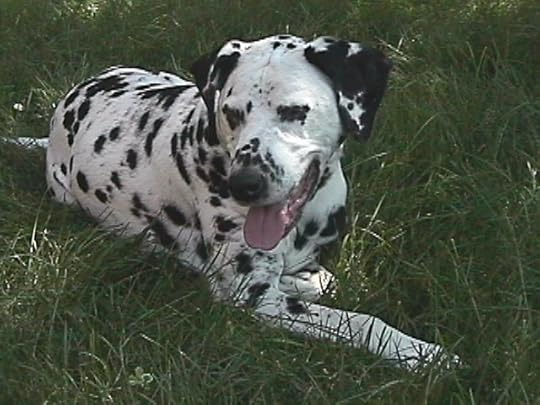
When we adopted Hogan at the age of 18-months-old, he was a very scared, abused puppy who desperately wanted to play and be loved. We realized early on that he had fears of flashlight, touch, and men with boots on their feet and hats on their heads. Developing his self-confidence was paramount in rescuing his self-confidence and daily happiness. Our goal was to get rid of the things that scared him. But... knowing that these scary elements would always show their ugly heads somewhere, we focused on developing his self-confidence so he wouldn't be frightened any longer.
Exercise was essential. As I have repeated many times, "A tired dog is a good dog." We took him on aerobic walks at least twice a day for a minimum of twenty minutes each time.

We found things that Hogan liked doing. He loved to run so we lunged him on a long line until we were able to move to our new home designed just for our pups. The lot is over five acres and fenced for safety. Then, we set up a lure course for him to chase his beloved "bunny," - the plastic bag!
Massage worked wonders!! Hogan learned that touch can be gentle and loving, and he came to trust our hands and the hands of others.
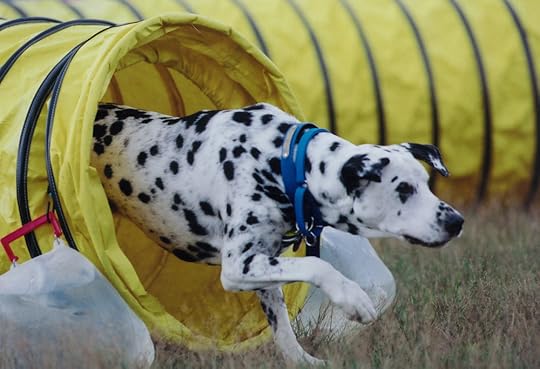
A mini agility course was built in our yard for him to jump, walk across, maneuver with great success. We could actually see the smile on his face at the end of each run.;
The more activities, the better the self-confidence. Our dogs developing good self-confidence is no different than our children! When they feel successful and are applauded, they soar. We were amazed at how many different things that Hogan loved doing. Not all dogs will like the same things, and that's OKAY! The best activity for some is walking. Yep! Just walk, and be sure to let your pup take in all the smells along the way.
By the way, like children, dogs need and want boundaries. A well-behaved, good-mannered dog makes going anywhere much more enjoyable. And... they feel good about being balanced and in control of their behavior.
Enjoy! Play! Walk! Read to! Hang out! Take drives! The list is endless.
Another great reward for having a well-balanced, happy, confident dog, is that they find a wonderful place in their forever home and are typically not returned to shelters.
"A righteous man cares for the needs of his animals."
We'd love to hear from you:
What are some of the things that you do with your special dog to have fun and enjoy time together? What activities does your dog enjoy, and you can tell he or she is having a great time?Do you see increased self-confidence when your dog is successful?July 24, 2018
Our Dogs Amaze us with their "intuitive" Powers

How many times does your special pup let you know that a thunderstorm is coming long before you ever hear or sense it coming? How many times has your dog gone running to the door without you hearing anyone approaching, or even see them coming up the long driveway?
Science hasn't figured out a way to actually figure out some of these things for certain. But... we do know that our dogs' senses are, in most cases, much greater than our own. For instance, our dogs' ears hear things a minimum of four times more than we do. Their sense of smell is thousands of times better than ours! Whoo! And it's very evident that our precious, smart four-legged companions are extremely aware of everything around them. Hence, our special dog is the smartest dog EVER! Sometimes, it seems as if they might even be smarter, or at least more aware of things than we are.
Dogs have the ability to smell the change in a person with diabetes whose blood sugar reaches dangerous levels. Cancer-sniffing dogs detect the specific scent that cancer cells emit. A person about to have a seizure is suspected, as well, to have a change in their personal scent, and even pregnant women have hormonal changes that change the way they smell. Dogs are known to recognize and give an alert to an episode with PTSD or extreme anxiety. I imagine the list is longer than we humans fully realize.
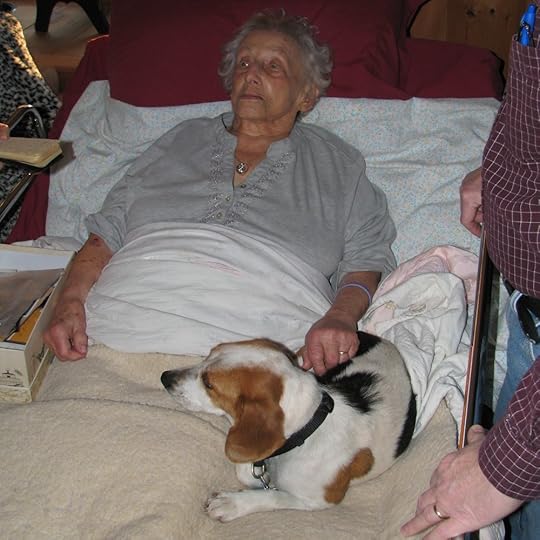
I have witnessed several times when a dog who shares a tight bond with their human is able to know when death is approaching and takes amazing steps to comfort and make certain that their person is not alone.
Some dog parents have reported situations when their pup has warned them of impending dangerous people. Again, aggressive people give off pheromones that dogs' noses can smell and then react with protectiveness of their special human. Their instincts are to keep their family safe from harm.
Our wonderful canine companions are quite in-tune with the forecast or weather. They easily undoubtedly detect “the drop in barometric pressure and the shift in the static electric field that comes prior to climate changes.” This may occur long before we see changes in the clouds or the rain begins to fall. Dogs who seek a dark, safe corner because of their fear of thunder are especially alert sounders for us as they exhibit anxiety through whining, whimpering, shaking, panting, salivating, or hunting out their sheltered spot to hide.
For me, what's most intriguing is my pups' ability to tell time. Well, maybe not literally read the clock but definitely have set schedules that I can set my watch! Judea comes to me when it's time for our walk - 11:00 AM. She seeks me out exactly at noon for her lunch snack and pesters me for dinner on the dot of 5:00 PM. And, Clarence used to let me know when it was time to wake up in the morning by giving me lots of wet, puppy kisses or go to bed at night by barking at the bedroom door.
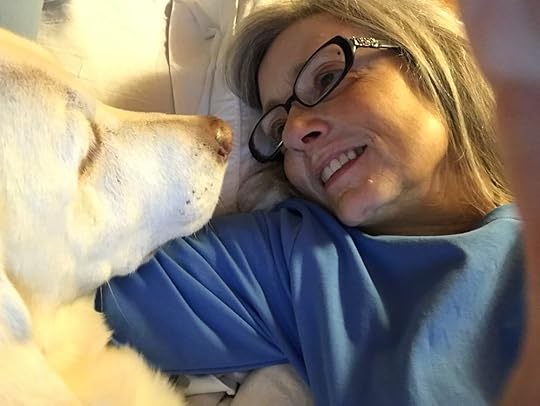
Our question for you today is: What kinds of things does your precious dog or dogs sense before you do? What do they alert you to happening? Please let us know by writing to us in the boxes below! We look forward to hearing from you! Tell us about it in the comments below!
July 18, 2018
The Teachings of our Animals
"A righteous man takes care of the needs of his animals." Proverbs 12:10
"Just ask the animals, and they will teach you." Job 12:7
This past week has been an astounding and remarkable journey through the pages of Hogan's Hope during which I was blessed to have had the amazing opportunities to talk with wonderful people who love their animals. We came together in different ways, as different individuals, but joined in our belief to accept any of these differences with love.

My first adventure was the beginning of a week-long book club discussion with the members of 2 Traveling Dogs Fans! Laurie Duperier, the author of The Endless Path, is the group's book club facilitator who approached me back in March. What a humbling honor to discuss my book, Hogan's Hope! Each day we focused on different topics that emanated from the pages of the book.
On the opening day of this very special time, for instance, I posted a video of Judea and me walking down our long, dirt driveway and thanking everyone for deciding to share in Hogan’s courageous journey and his message of hope. Fans were invited to share their thoughts on how their own dogs might be hoping for something or what their precious four-legged family members have taught them. Every day was filled with revealing feelings, ideas, and revelations. A couple of the members candidly admitted that they had never thought of their dogs hoping for anything. What a grand time of learning so much of what our non-verbal family members have and can actually teach us.
Hogan was an amazing gift, and as the years passed, it became clear that I was to write his book, Hogan's Hope, to share the story of a deaf, eighteen-month-old puppy who was rescued from severe neglect, adopted into a forever home, and went on to learn, grow, and demonstrate how extremely successful a "handicapped" dog can be in living a perfectly normal life. Hogan learned over seventy words in American Sign Language, agility, flyball, tracking, lure coursing, and even became a certified therapy dog. He appeared on television shows and showed the world how wonderful deaf dogs can be as family members. Over the course of his lifetime, Hogan taught me how to hope. Many people doubt me. Many folks ask me, “How can a dog, and a deaf one at that, teach you to hope?”
Thought: Do you believe that a dog can teach us how to hope? What are your thoughts on that? Would you share with us some examples of what your dog has taught you?
Each day became better than the one before, and Coco, the parrot, even joined us for some input! Judea and I (with the help of Jim, our wonderful papa and husband) posted a video to open the day's topic and discussion. I was extremely rewarded with great friendship, powerful feelings, and increased hope.
THEN.... off to do a radio interview at iCRV radio, (www.iCRVRadio.com), with Kate, Gwen, and LRB for The Library Chat. What a fantastic program with three dynamic and talented women who produce a show that is filled with great information, warm feelings, and thought-provoking ideas and comments.

Kate Branstetter, Connie Bombaci, Judea, and Gwen Pond
We spent a half hour talking about Hogan's Hope, deaf dogs, animals in general, and how each non-human family member is so important to our lives.
But... our week had yet another outstanding opportunity to participate in our very first podcast with Sean Farjadi and his Stories that Empower. Sean's purpose, in his words,
"First, each of us has a story to tell. Throughout our lives, from childhood to adulthood, we are drawn to stories. It’s what connects us... 'stories link lives'.
Second, we’ve all experienced setbacks and challenges. Loss of a job, loss of identity, loss of a loved one, etc … I want people to know they are not alone and that there is hope/light. It brings me so much joy, if/when I’m able to ‘lift up’ someone or empower them. My goal is to provide a service that brings inspiration, hope, and empowerment through the power of stories."
I was again able to share that Hogan taught me how to hope and why animals have touched my life in such powerful and positive ways.
Enjoy your week, dear followers. Our lives have great and wonderful stories to share. Share, share, and share some more. God bless!
July 5, 2018
Saving Our Pets' Lives

Summer is here, and picnics with lots of yummy treats abound. Many of us are very tempted to indulge our pets with tastes from our party foods. But, before doing that, we MUST consider the dangers of some of the foods. STOP and think about what items are possible toxins and can harm our beloved, four-legged family members.
The top ten dog toxins that are listed by the Pet Poison Helpline include:
1. Chocolate
2. Caffeine and caffeine pills
3. Rodent Poisons
4. Ibuprofen and acetaminophen
5. Xylitol (the sweetener used in candy and sugar-free gum)
6. Anti-depressant medications or any medication
7. Fertilizers (Better to have a not-so-perfect lawn than one that will harm our pets)
8. Grapes and raisins
9. Decongestants
10. Vitamin D overdose
The sun also can be dangerous, and dogs are susceptible to sun burns. Overheating, heat strokes, and dehydration are other real threats to our pets' lives, and we must take precautions. Of course, leaving our pets in cars is absolutely out of the question!! Sure, it's fun to take them everywhere with us, BUT having them alive with us is a much better than the momentary pleasure that could turn deadly in a matter of short minutes.
NEVER exercise your pet in the heat of the day. Wait until cool evening hours or get up early before the temperatures get hot.
Provide plenty of fresh water. Several bowls scattered throughout the home AND outside are extremely important.
If your pet is overheated, wait to feed until he cools down. Bloat is lethal.
Keep the Pet Poison telephone number posted in a place that you don't have to go searching. 1-800-213-6680 and www.petpoisonhelpline.com are available 24 hours a day, 7 days a week. There is a fee for each incident but well worth the cost to save a life.
With great care and thoughtful planning, you and your wonderful pets will be better able to enjoy a safe summer!
June 29, 2018
Talking to the Animals

Talking with our pups may seem silly and sound funny to folks who don't have pets, but communication is the key to success in any relationship. My pup is deaf and I still talk to her. She responds to my facial expressions, feels my tone, and enjoys the time that I spend focusing my attention on her. Sure, it all may seem one-sided, but there are many benefits that you may not even be aware.
First of all, talking with our pets is great for us! Yep! That's right. It's good for us. Our pets, hearing or non-hearing, pay very close attention to us. Talking about our daily events or our concerns and problems without being judged is actually quite helpful to our well being. Often, just putting our thoughts out on the table helps us to find a solution or merely some wonderful peace of heart. Relieving our stress is always good for our health!
Our bond with our pets—dogs, cats, horses, gerbils, etc.—is powerful. Love is the main reason that we adopt our wonderful family members. Companionship is also a compelling factor. By talking with our pets, we open up our minds, our thoughts, and our hearts even more than if we simply sit with no interaction. True relationships take real effort, dedicated time, and genuine devotion. Engaging them during moments when we aren't necessarily active with them creates quality moments and initiates communication that creates a two-way opportunity and reason to remain connected.
So, keep talking! We will be much better off and our beloved pets will smile with the feeling of being important to our lives.
April 25, 2018
Nine Springtime Hazards for our Pets
Posts by:
Pet Health Network Contributors
After a long winter, we’re sure that you’re ready to get outside with your dog. While we couldn’t agree more, don’t overlook these 9 hazards of the season.
1. Ticks and Tick-borne Disease
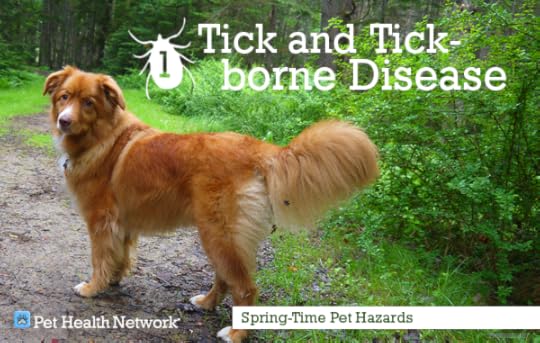
Ticks are more than just creepy; they can spread a number of different diseases that affect both pets and people: Lyme disease, ehrlichiosis, Rocky Mountain spotted fever, anaplasmosis, tularemia, and babesiosis. The best way to protect your pet is with preventative treatment. Ask your veterinarian for advice and click here to learn more about ticks and the diseases they spread.
Also check out this article: New Study Shows Link Between Ticks and Kidney Disease
2. Antifreeze
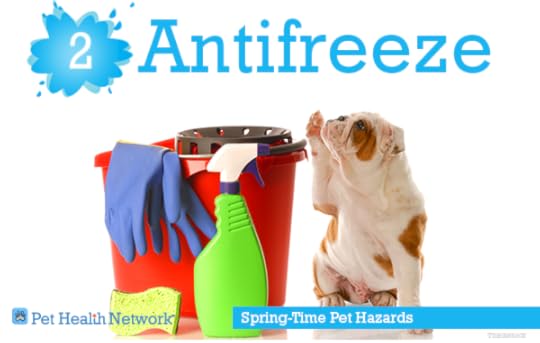
Antifreeze is extremely dangerous to pets because most types have a sweet smell and taste—dogs tend to dive right in and lap it up. Because of this, antifreeze poisoning is one of the most common forms of poisoning in pets. Fortunately, “pet-safer” types of antifreeze that are not as attractive to pets are available. Beware, antifreeze is not the only garage hazard.
3. Heartworm
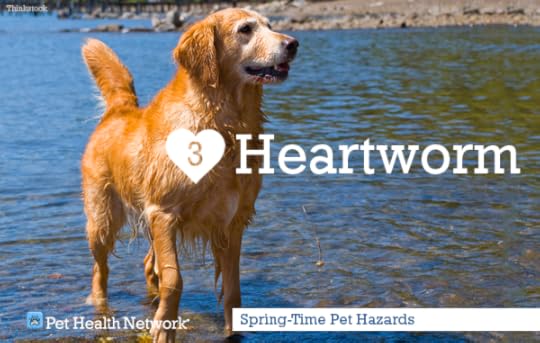
Heartworm disease is transmitted by mosquitoes. It is a serious disease that primarily affects the heart and lungs, but can also affect the liver, kidney, eyes, and central nervous system; if left untreated, it can cause death. Fortunately, effective preventatives are available.
4. Fertilizers and Mulch
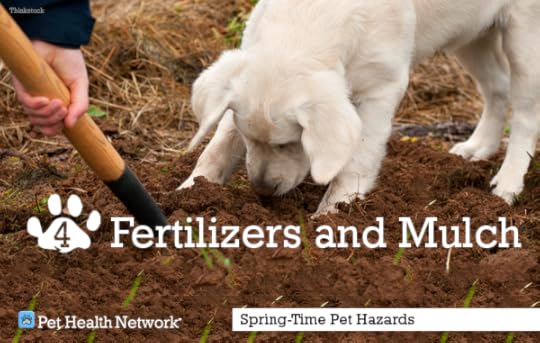
According to the PetPoisonHelpline, most fertilizers contain a wide assortment of potentially toxic substances including iron and nitrogen. They could also have pesticides, fungicides, or herbicides. Even if the chemicals don’t poison your pet, large amounts of fertilizer could result in gastrointestinal or pancreatic problems.
5. Metaldehyde (Slug Bait)
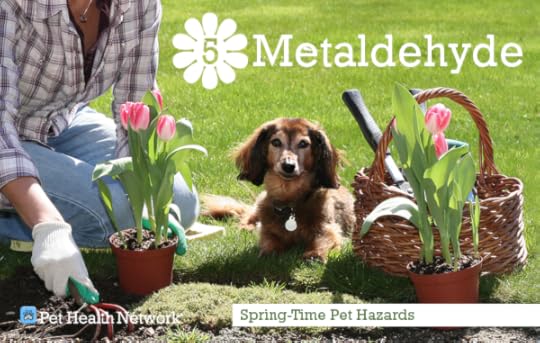
Snail bait represents a major risk for dogs and cats and is a more common source of poisoning than you may expect. Snail and slug bait products typically contain the poison metaldehyde, and they taste sweet to pets. It’s important that you know the symptoms of metaldehyde poisoning in case your pet is exposed.
6. Bee Stings
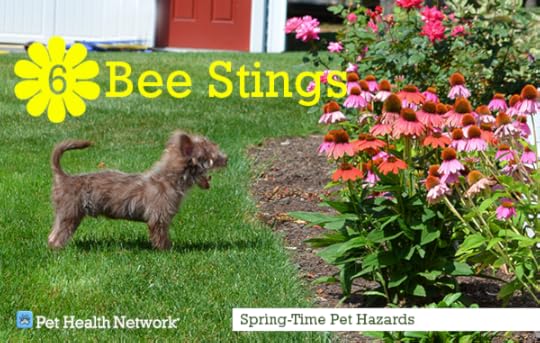
Like people, some dogs can have an allergic reaction to bee stings, especially if stung by multiple bees. Talk to your veterinarian about how you can keep your pup safe from bee stings, and what to do if your dog is stung.
7. Snakes

There are 20 species of venomous snakes in North America, and they are found in every state except Alaska, Hawaii, and Maine. A rattlesnake can bite your dog even if the meeting is not face-to-face. Rattlesnakes can strike as far as half of their own body length. Although they usually warn before striking by rattling their tail, they don't always. Learn more about venomous snakes here.
8. Thawing Ponds
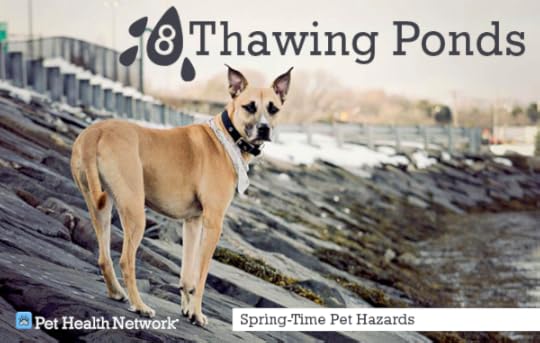
Your dog may be accustomed to taking walks over ice covered lakes, rivers and ponds. As the ice begins to thaw, the new dangers presented by exposed water are likely not going to be apparent to him. By keeping your dog on a leash you can protect him from falling through the thin ice.
9. Ivermectin

Horse dewormers often contain ivermectin; it’s also used in small doses to kill parasites in dogs. Toxicity can occur if a dog is given an excessive dose of the medication. To prevent ivermectin toxicity keep horse products out of his reach and only administer the prescribed amount of heartworm medication as instructed by your veterinarian.
If you have any questions or concerns, you should always visit or call your veterinarian -- they are your best resource to ensure the health and well-being of your pets.
Reviewed by:
April 9, 2018
Hogan's Hope receives prestigious Benjamin Franklin Silver Medal

2018 Benjamin Franklin Silver Medal awarded to Hogan's Hope: A Deaf Hero's Inspirational Quest for Love and Acceptance
(Manhattan Beach, CA - April 9, 2018) -- The Independent Book Publishers Association (IBPA) – www.ibpa-online.org – announced over the weekend the gold winners in the prestigious IBPA Benjamin Franklin Award™ program, now in its thirtieth year.
This year’s esteemed indie book award program recognized excellence in books published during the calendar year 2017. From close to 1,500 entries, one gold winner was named in each of fifty-four categories. Silver winners were also named in each category. Hogan's Hope: A Deaf Hero's Inspirational Quest for Love and Acceptance received the notable Silver Medal.
See the full list of winners in all fifty-four categories here.
The gold winners were announced on Friday, April 6, 2018, during a gala dinner ceremony programmed at the end of the first day of IBPA Publishing University, a two-day conference with over 30 educational and networking sessions developed to foster collaboration within the independent publishing community. Both the dinner ceremony and the conference took place at the Sheraton Austin Hotel at the Capitol in Austin, Texas. Read Publishers Weekly's take on IBPA Publishing University 2018 here.
"This year's list of IBPA Benjamin Franklin Award™ winners rest at the pinnacle of professional independent publishing. These are the best of the best," said IBPA CEO Angela Bole. "This is important because, in the end, it’s not just about publishing; it’s about publishing well. Becoming an IBPA Benjamin Franklin Award™ winner showcases a publisher’s commitment to professional standards and high-quality book content and production."
For 30 years, the IBPA Benjamin Franklin Award™ program has been regarded as one of the highest national honors for small and independent publishers. This year’s gold winners include a variety of books from independent publishers large and small, hybrid presses, self-published authors, and major national groups like the National Association of Home Builders and The White House Historical Association.
Over 150 librarians, booksellers, and design and editorial experts – most of whom have decades of book industry experience – judge the books submitted to the IBPA Benjamin Franklin Award™ program. The judging process takes seven months, beginning in September and continuing into March each year. At the end of the process, every entrant receives written critiques from the three individual judges who reviewed their book. The critiques include constructive feedback to help each publisher understand how their book is being perceived by industry professionals, upholding part of IBPA’s mission to serve the independent publishing community through education.
The call for entries into the 31st annual IBPA Benjamin Franklin Award™ program (for books with a copyright date of 2018) opens in late April 2018. Visit ibpabenjaminfranklinawards.com for more information.
FOR MORE INFORMATION
Contact Terry Nathan, IBPA COO, at terry@ibpa-online.org
About the Independent Book Publishers Association
Founded in 1983 to support independent publishers nationwide, the Independent Book Publishers Association (IBPA) leads and serves the independent publishing community through advocacy, education, and tools for success. With over 3,000 members, IBPA is the largest publishing association in the US. Its vision is a world where every independent publisher has the tools and knowledge needed to professionally engage in all aspects of the publishing industry. For more information, visit ibpa-online.org.
About the IBPA Benjamin Franklin Award™ Program
The IBPA Benjamin Franklin Awards™ are administered by the Independent Book Publishers Association (IBPA) with help from over 150 publishing professionals, including librarians, bookstore owners, reviewers, designers, and editors. All entrants receive direct feedback from the judges which is sure to help guide future publications. For more information, visit ibpabenjaminfranklinawards.com.
April 7, 2018
Tug of War with our Dogs

Judea, deaf dog, waits to be told that she can play.
Tug-of-war is a long-time game that we humans love playing with our loving, playful canine family members. But, to play safely and successfully, we MUST play by the rules.
Most of the information that I am presenting to help us experience successful play is gleaned from an article that is several years old and written by Pat Miller for the Whole Dog Journal. While published in November of 2013, it continues to offer great guidelines for playing tug-of-war with our beloved dogs. The bottom line—we are the "masters," and we must remain in control in order to provide for the safety and protection of two-legged and four-legged family members. Let's have fun, safe playtime.
Rules for Playing Tug of War With Your DogInformation excerpted from an article by Pat Miller
Tug is a great game to play with your dog to work off energy and allow us to roughhouse safely. It won’t make him “dominant,” and it won’t make our dogs aggressive, as long as we play by the rules. And it’s the process of being able to follow the rules and exhibit a degree of self-control that makes this game such a great one for Do-Over Dogs. The rules are designed to remind our pups that we are the ones who are the leaders—in charge. Following the rules also let our dogs know which behaviors are acceptable.
1. Use a toy or rope that is sturdy and long enough to keep your dog’s teeth away from hands. It should be comfortable for holding during the pulling. Remember to keep the tug toy stored away until it's time to play.
2. Hold out the toy or rope. If your dog lunges for it, make a correction sound and keep it at a distance or behind your back. Be sure to let your dog know that it's your toy. The game is played only when permission is given.
3. Your pup needs to sit until you invite him or her to grab it. Be gentle yet enthusiastic.
4. During the game, be sure to take breaks which require your dog to give up the toy to you. Again, the toy belongs to the human! The game is played by our rules—not the dog's rules!! And, perhaps most importantly, the human ALWAYS wins—ends up with possession of the toy, not the dog.
5. If the mouth or teeth begin to get too close to your hands, you need to be sure to let your pup know immediately with a positive "correction," taking possession of the rope, and giving a short break from tugging. This sets clear boundaries that our dogs can understand.
6. Similarly, if teeth touch any part of your body or clothing, give a gentle correction immediately and take a break. Depending on the intensity, you might consider putting away the rope or toy for a while.
7. Store the tug toy until you want to play again.
8. Small children should NOT play tug with your dog. Older children might be able to handle the game but ONLY if everyone is absolutely certain that all the rules can be followed without exception.
I believe that it's only fair to let our pets know what the rules are in any game or activity. We want to know the rules, so do they! Happy and safe playing! Create fun times for everyone!
Adapted from Whole Dog Journal's FREE Tip of the Week November 2013.
April 3, 2018
March 25, 2018
Caring for our Deaf Dogs, Any Dog, and More

With approximately 79% of American households having a dog, cat, or both and more homes having other types of pets, I paused to ponder the thought, "How many of those homes know how to properly care for their non-human family members?" And, "How many actually take the proper measures to perform the things that will ensure a happy, healthy life for their non-human family members?"
I admit that I know much more about dogs than cats, birds, reptiles, or other furry friends. However, I do know that they all have specific needs that we must be responsible enough to learn and practice regularly. Caring for anyone takes time, money, and lots of love. Responsibility is at the top of the list, and everything should be considered before we make that final decision to adopt. The number of animals surrendered, or abandoned, at shelter centers is mind-boggling. Behavior issues are major reasons that animals are given up or "thrown away." Sure, puppies and kittens are cute and cuddly when they're little and young, but they grow up. Their size and maturity can become problematic if the adopters don't take proper steps in teaching good manners and appropriate behavior. Like children, our precious animals need regular direction, constant teaching, and daily activity and socialization. And, if problems begin to show themselves, immediate measures to correct the issue is essential. Ruling out any physical or medical condition that may be causing the behavior issue is critical.
These problem behaviors can include separation anxiety, chewing, biting, growling, going potty inside, and fears. Dogs can exhibit their fears of other dogs, other animals, noises, people, or situations by cowering, tucking their tails between their legs, hiding, barking, growling, lunging or biting. Getting immediate help is key. Waiting is not a good option. The longer the behavior is allowed to exist, the harder it will be correct it.
Regular check-ups and vaccinations are extremely important in preventing any major medical problems. Vaccinations are administered on a routine that is set up by your veterinarian needs to be followed without compromise. Some vaccines are mandated by law, such as Rabies. Core vaccinations against Parvovirus include Distemper/Adenovirus/Parainfluenza/and Parvovirus (DAPP). This virus is fatal and causes severe diarrhea and vomiting. Adenovirus can affect the liver. Additional vaccinations for our pups include Leptospirosis, Bordetella, Lyme, Canine Influenza.
In order to help control the animal population, spaying and neutering our dogs is the responsible choice. Too many pets are being born than there are homes, and every year millions of precious, loving dogs are being destroyed. Low-cost spay and neuter clinics offer affordable assistance to help families on a limited income.
The myths that our pets will become fat or experience a change in their personality are untrue. In fact, the benefits are numerous which include preventing certain types of cancer, being less attracted to the opposite sex, roaming less, arguing with other animals, and living longer lives.
The responsibilities and proper care of our four-legged family members are numerous and go much farther than this short blog. Nutrition, grooming, housing, exercising, training, and so much more will be addressed in the future.
Please treat our wonderful and loving animals as you would want to be treated and taken care of on a daily basis.
"So in everything, do to others what you would have them do to you." Matthew 7:12 NIV



